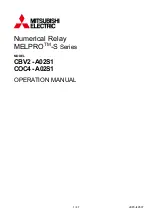
Line voltage drop compensation for parallel control
The line voltage drop compensation for a single transformer is described in section
. The same principle is used for parallel control with the
circulating current method and with the master – follower method, except that the total
load current, I
L
, is used in the calculation instead of the individual transformer current.
(See figure
for details). The same values for the parameters
Rline
and
Xline
shall
be set in all IEDs in the same parallel group. There is no automatic change of these
parameters due to changes in the substation topology, thus they should be changed
manually if needed.
Avoidance of simultaneous tapping
Avoidance of simultaneous tapping (operation with the circulating current
method)
For some types of tap changers, especially older designs, an unexpected interruption
of the auxiliary voltage in the middle of a tap manoeuvre, can jam the tap changer. In
order not to expose more than one tap changer at a time, simultaneous tapping of
parallel transformers (regulated with the circulating current method) can be avoided.
This is done by setting parameter
OperSimTap
to
On
. Simultaneous tapping is then
avoided at the same time as tapping actions (in the long term) are distributed evenly
amongst the parallel transformers.
The algorithm in Automatic voltage control for tap changer, parallel control
TR8ATCC will select the transformer with the greatest voltage deviation U
di
to tap
first. That transformer will then start timing, and after time delay
t1
the appropriate
URAISE or ULOWER command will be initiated. If now further tapping is required
to bring the busbar voltage inside
UDeadbandInner
, the process will be repeated, and
the transformer with the then greatest value of U
di
amongst the remaining
transformers in the group will tap after a further time delay
t2
, and so on. This is made
possible as the calculation of I
cc
is cyclically updated with the most recent measured
values. If two transformers have equal magnitude of U
di
then there is a predetermined
order governing which one is going to tap first.
Avoidance of simultaneous tapping (operation with the master follower
method)
A time delay for the follower in relation to the command given from the master can be
set when the setting
MFMode
is
Follow Tap
that is, when the follower follows the tap
position (with or without an offset) of the master. The setting parameter
tAutoMSF
then introduces a time delay on UVRAISE/ULOWER commands individually for
each follower, and effectively this can be used to avoid simultaneous tapping.
Homing
Homing (operation with the circulating current method)
This function can be used with parallel operation of power transformers using the
circulating current method. It makes possible to keep a transformer energized from the
HV side, but open on the LV side (hot stand-by), to follow the voltage regulation of
1MRK 502 071-UEN -
Section 15
Control
Generator protection REG670 2.2 IEC and Injection equipment REX060, REX061, REX062
563
Application manual
Summary of Contents for Relion REG670
Page 1: ...RELION 670 SERIES Generator protection REG670 Version 2 2 IEC Application manual...
Page 2: ......
Page 108: ...102...
Page 132: ...126...
Page 324: ...318...
Page 442: ...436...
Page 476: ...470...
Page 628: ...622...
Page 718: ...712...
Page 728: ...722...
Page 768: ...762...
Page 778: ...772...
Page 779: ...773...
















































